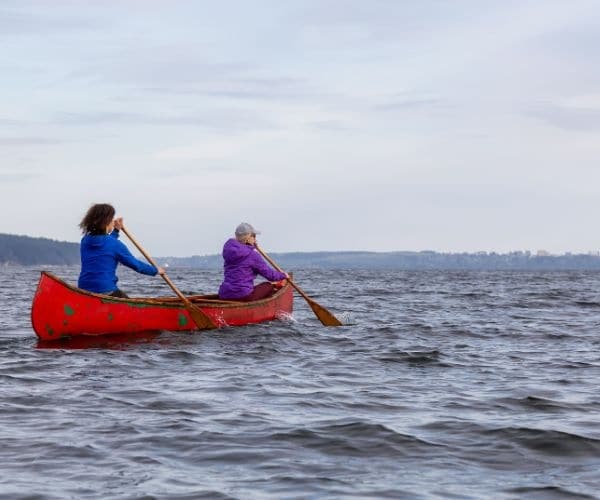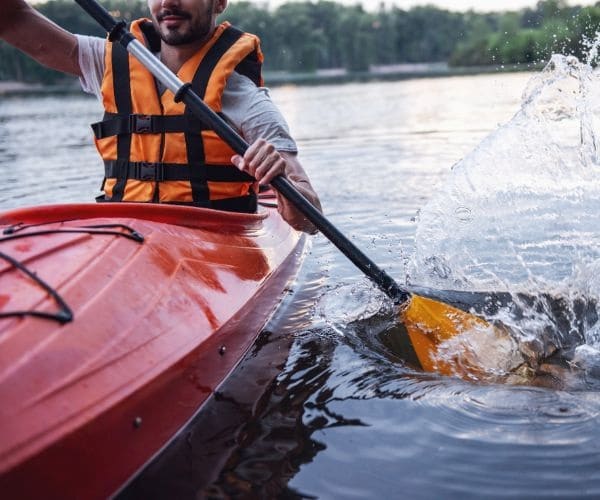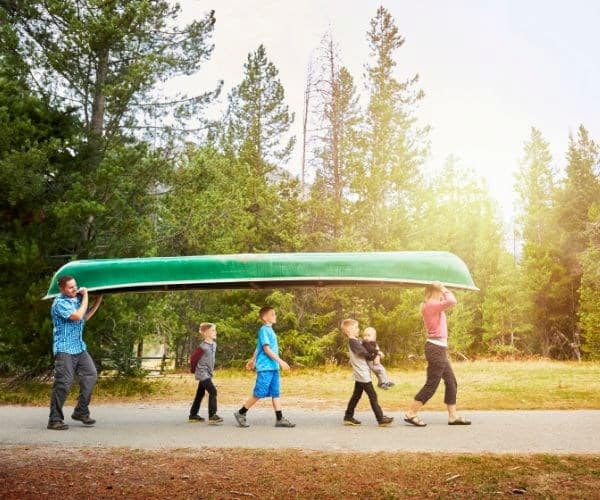If you’ve ever wandered along a British canal, explored the coast, or paddled on a quiet lake, you’ve probably seen both canoes and kayaks gliding across the water. But what’s the difference? Many people use the terms interchangeably, but they’re actually quite distinct.
When it comes to shape, space, and size, there are distinct differences that make these vessels unique—and certainly not to be mistaken for one another. We’ve highlighted some key areas to provide a clear and simple comparison between the two.
It could be the technique, seating position or overall purpose that makes you prefer one over the other. Either way we’ve explored the differences further to find out which way you might paddle.
What makes a kayak a kayak?

A kayak is a sleek, enclosed boat where the paddler sits low to the water with legs stretched out in front. Unlike canoes, kayaks use a double-bladed paddle, allowing for efficient strokes on both sides. Originally developed by the Inuit for hunting in icy waters, modern kayaks are built for everything from casual paddling to high-speed racing and whitewater adventures. They’re faster, more agile, and often more suited for choppy water or long-distance travel.
Kayaks come in two main styles: sit-in and sit-on-top. Sit-in kayaks have a cockpit, sometimes with a spray deck to keep water out, while sit-on-top kayaks are open and popular for leisure paddling and fishing. If you fancy skimming across the sea or tackling a whitewater rapid, a kayak might be your best bet.
What makes a canoe a canoe?

A canoe is the classic, open-top boat where the paddler either kneels or sits on a raised seat, using a single-bladed paddle. Different from kayaks, canoes are generally wider, offering greater stability and making them excellent for carrying gear, passengers, or even a dog! They’ve been used for centuries as transport vessels across rivers and lakes, with origins in Indigenous cultures around the world.
Canoes are often chosen for leisurely paddling, family trips, and long-distance expeditions. They’re perfect for exploring the Norfolk Broads, Scottish lochs, or slow-moving rivers like the Wye, where space, comfort, and storage matter more than speed. If you like the idea of a relaxed paddle with a picnic in tow, a canoe might be the way to go.
Differences in purpose, usability & design

While canoes and kayaks both fall under the paddling umbrella, they serve slightly different purposes – and the right one for you really depends on the kind of experience you’re after.
Purpose
Canoes are typically used for leisurely paddling, family outings, or multi-day adventures where you might want to bring a picnic, camping gear, or even your dog. They’re perfect for gliding down a quiet canal, exploring a lake, or meandering along a slow-moving river.
Kayaks, in contrast, are often built for speed, solo travel, and tackling more dynamic environments like coastal waters or whitewater rivers. If you’re keen on performance, challenge, or covering longer distances more efficiently, kayaking might be more your speed.
Usability
Canoes are quite straightforward and stable, especially on flat water. Getting in and out is easy, and there’s room to move around a bit. For new paddlers, this can feel more relaxed and less restrictive. However, paddling a canoe solo does require a bit of technique, especially if you’re trying to stay on course.
Kayaks might feel a little less forgiving at first – you’re sitting low, often enclosed in the boat – but they give you greater control and are generally more agile, especially in windy or choppy conditions. If you’re a beginner who enjoys learning new techniques and wants to grow into the sport, a kayak can be very rewarding.
Design
Canoes have a very open and airy feel – wide hulls, open tops, and high seating make them feel almost like floating armchairs. Kayaks are more like sports cars – narrow, enclosed (unless it’s a sit-on-top), and designed to slice through water quickly and efficiently. If you’re someone who prefers a sense of freedom and space, you might lean towards a canoe. If you like the feeling of being snug in your boat, connected to the movement of the water, a kayak might be your best mate.
Differences in seating, space, paddles & equipment

Let’s break down the practical side of things – where you’ll sit, how much you can carry, and what kit you’ll need.
Seating
In a canoe, you’ll usually sit on a raised bench seat or sometimes kneel, especially if you’re paddling solo and need extra control. This gives you a nice high perspective of your surroundings.
Kayakers, on the other hand, sit low down with legs stretched out in front, which lowers your centre of gravity and helps with balance, especially in rougher water. For newcomers, the idea of being “in” a kayak rather than “on” a canoe can feel a bit confined at first – but many get used to it quickly and end up loving the sense of stability it provides.
Space
Canoes win hands down when it comes to space. There’s plenty of room for bags, kids, pets, fishing gear, or a full camping setup. This makes them ideal for longer trips or group outings.
Kayaks are more compact, especially sit-in models, though many have storage hatches or deck rigging to carry smaller dry bags. If you’re someone who travels light and likes a nimble craft, a kayak will serve you well. But if you want to bring everything but the kitchen sink – or just like having room to move – the canoe is your go-to.
Paddles
Canoes use a single-bladed paddle, so you’ll either alternate sides or use strokes like the J-stroke to steer. It can take a bit of practice, especially when paddling solo.
Kayaks use a double-bladed paddle, which feels more rhythmical and intuitive for many beginners. If you’re looking for something that feels flowing and efficient right from the get-go, kayaking has that appeal.
Other Equipment:
• Canoeing gear tends to be quite minimal – a paddle, a buoyancy aid, maybe a bailer for splashed water, and you’re good to go.
• Kayaking, especially in cooler or rougher conditions, might require a few more bits: spray decks to keep the cockpit dry, dry bags, helmets for whitewater, and often wetsuits or drysuits, as you’re more likely to get wet.
For someone just starting out, the amount of kit you’re comfortable with can help you decide. If you prefer a minimal setup and the option to stay relatively dry, a canoe might be your cup of tea. If you enjoy a bit more technical gear and the idea of growing into a more performance-oriented paddling style, kayaking is the way forward.
Different types of Canoes & Kayaks

Not all canoes and kayaks are created equal – in fact, there’s quite a bit of variety depending on where you want to paddle and what kind of experience you’re after. Here’s a helpful breakdown of the main types you’ll come across, and what each is best suited for:
Canoe Types
Recreational Canoes
These are the most common type of canoe, perfect for gentle paddling on calm lakes, canals, and slow-moving rivers. They’re stable, easy to handle, and often made from durable materials like polyethylene.
Touring Canoes
Built for longer journeys, touring canoes are designed with efficiency, comfort, and cargo space in mind. They tend to be longer and narrower than recreational models, allowing them to glide through the water with less effort. Ideal for multi-day expeditions, especially if you’re carrying camping gear, dry bags, or food supplies.
Whitewater Canoes
These are shorter, more manoeuvrable, and usually built from tough, impact-resistant materials. They often come with high sides and flotation panels to deal with splashing water and waves. Perfect for paddlers who want to navigate rapids and rougher river conditions, though they do require more technical skill to control.
Kayak Types
Recreational Kayaks
These are designed for flatwater paddling on lakes, canals, and gentle rivers. They’re wider for stability and typically shorter than touring kayaks, making them easier to manoeuvre and control. Great for beginners, casual users, or those who just want a relaxed paddle without the fuss.
Touring (Sea) Kayaks
Touring kayaks are longer, narrower, and built for speed and efficiency over distance. They often feature storage compartments for gear, and many include rudders or skegs to help with tracking in windy or choppy conditions. These are ideal for paddling along the UK coastline, across open water, or embarking on extended day trips.
Whitewater Kayaks
Compact, curved, and ultra-manoeuvrable, whitewater kayaks are built to handle the twists, turns, and turbulence of fast-moving rivers and rapids. Their responsive design allows for quick movements, rolls, and tricks, making them the weapon of choice for thrill-seekers and experienced paddlers.
Sit-on-Top Kayaks
Unlike traditional kayaks, there’s no enclosed cockpit – you sit on top, which makes them easy to get on and off. They’re super stable and less claustrophobic, but you will likely get a bit wetter. Great for warm weather, short sessions, and simple fun on flat water.
Canoeing vs. Kayaking in competitive sports
If you’re after a competitive edge, both canoes and kayaks offer exciting disciplines.
• Kayak Racing: Includes sprint, slalom, and marathon races, popular in Olympic events.
• Whitewater Kayaking: Features extreme rapids, tricks, and high-adrenaline descents.
• Canoe Slalom & Sprint: Both are Olympic sports where athletes race through challenging courses.
• Marathon Canoeing: Long-distance endurance events, popular in the UK.
If speed and adrenaline are your thing, kayaking might be the way to go. If you enjoy technical skill and endurance, canoeing has its own challenges.
Canoe or Kayak – So, which should you choose?
Still not sure which boat is right for you? Both have their perks, and a lot depends on what you want from your paddling experience. Here’s a quick breakdown to help steer your decision:
For beginners
Sit-on-top kayaks are a fantastic choice – they’re stable, easy to get on and off, and ideal for building confidence on calm water.
Likewise, wide, recreational canoes are perfect for those who want a gentle intro to paddling without feeling confined. If you prefer staying drier and having space to move, the canoe might edge ahead.
For speed & fitness
Kayaks tend to be faster and more efficient in the water, making them ideal for those looking to get a workout in or cover longer distances.
For family & leisure
Canoes shine here. Their open design and roomy interior make them perfect for family adventures, paddling with a partner, or bringing along your dog and a cool box.
For adventure & challenges
Kayaks really come into their own when the water gets a bit wild. Whether it’s tackling whitewater rapids, navigating sea caves along the Cornish coast, or exploring remote Scottish lochs, the kayak’s low profile and manoeuvrability make it the better option for high-adrenaline and technical paddling.
To sum up...
Both canoes and kayaks offer amazing ways to enjoy the UK’s stunning lakes, rivers, canals, and coastline or venture abroad. Canoes are stable, spacious, and sociable – perfect for relaxed adventures and shared outings. Kayaks are nimble, speedy, and adventurous – ideal for solo explorers and thrill-seekers alike.
So, if you’re looking to cruise peacefully through nature, maybe with a thermos of tea and a pair of binoculars, a canoe is a brilliant choice. But if you’re drawn to speed, waves, or the thrill of tackling rapids, a kayak will likely grab your attention.
Get Kayaking or Canoe Insurance from SportsCover Direct
SportsCover Direct covers over 500 sports and activities, including kayaking and canoeing and specialises in the extra cover you might need when doing something more specialist or extreme.
Our Kayaking Insurance and Canoeing Insurance can give you worldwide cover and is designed to give financial protection for medical and repatriation costs, cancelled trips and more. You can also opt for a bolt-on, Activity Top-Up, to add to your existing policy for specialist activities, that may not be covered on a standard policy.
For waterway enthusiasts in the UK you can opt for our Sports Accident policy, select the activities you need cover for, when you request a quote.
Find out more and get a personalised quote online in minutes.
This blog has been created as general information and should not be taken as advice. Make sure you have the correct level of insurance for your requirements and always review policy documentation.